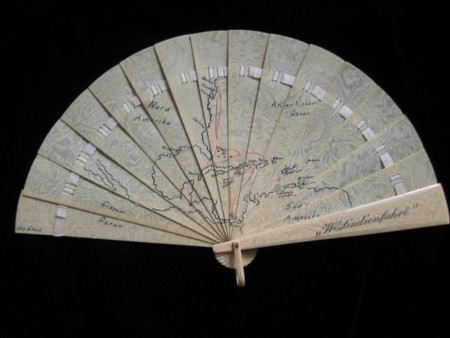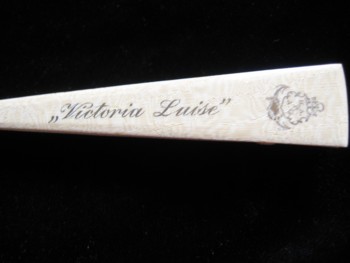
Moiré-strukturierter Zelluloid-Fächer, auf dem in roter Linie die Westindien-Fahrt der "Victoria Luise" der Hamburger HAPAG Schifffahrtsgesellschaft ("Hamburg-Amerikanische Packetfahrt Aktiengesellschaft") abgebildet ist. Sie startete von New York und fuhr über die Bahamas, Kuba, diverse Antilleninseln bis vor die Küste Venezuelas (sogenannte Westindische Inseln. Zur Erinnerung: Der Name stammt von Kolumbus, der ja Indien gegen Westen segelnd erreichen wollte. Daher glaubte er, die Inseln, die er entdeckte, seien "westlich von Indien"). Aufgrund der Geschichte der HAPAG-Flotte und der Victoria Luise kann der Fächer zwischen 1911 und 1914 datiert werden, als Victoria Luise für Karibik-Fahrten eingesetzt wurde. Herkunft: Deutschland. Es ist interessant, dass das Exemplar in Cynthia Fendels Buch (Seite 36) eine andere Route eingezeichnet hat. Das erklärt vielleicht auch die andere Datierung, nämlich 1900-1906, als das Schiff noch für Atlantik-Querungen eingesetzt wurde.
Moiré-structured celluloid fan where the red line indicates the cruise route of the Victoria Luise on her West Indies cruise. She was a vessel of HAPAG (the abbreviation stands for "Hamburg-Amerikanische Packetfahrt Aktiengesellschaft", a Hamburg-American shipping line). She started from New York, passed by Nassau and Cuba and other Antille islands until the Venezuelan coast (so-called Westindies. Remember: Columbus gave them the name, as he sailed westwards to discover a new sea route to India. Thus, he assumed that the islands he discovered are "west of India"). Given the history of HAPAG steamers and in particular, the Victoria Luise, the fan can be dated between 1911 and 1914 where Victoria Luise was assigned the Carribbean route. Provenience Germany. It is interesting that the route on the fan shown in Cynthia Fendel's book (p. 36) is different. This fact might also account for the different date, i.e. 1900-1906, when the vessel was still used for Atlantic crossings.
